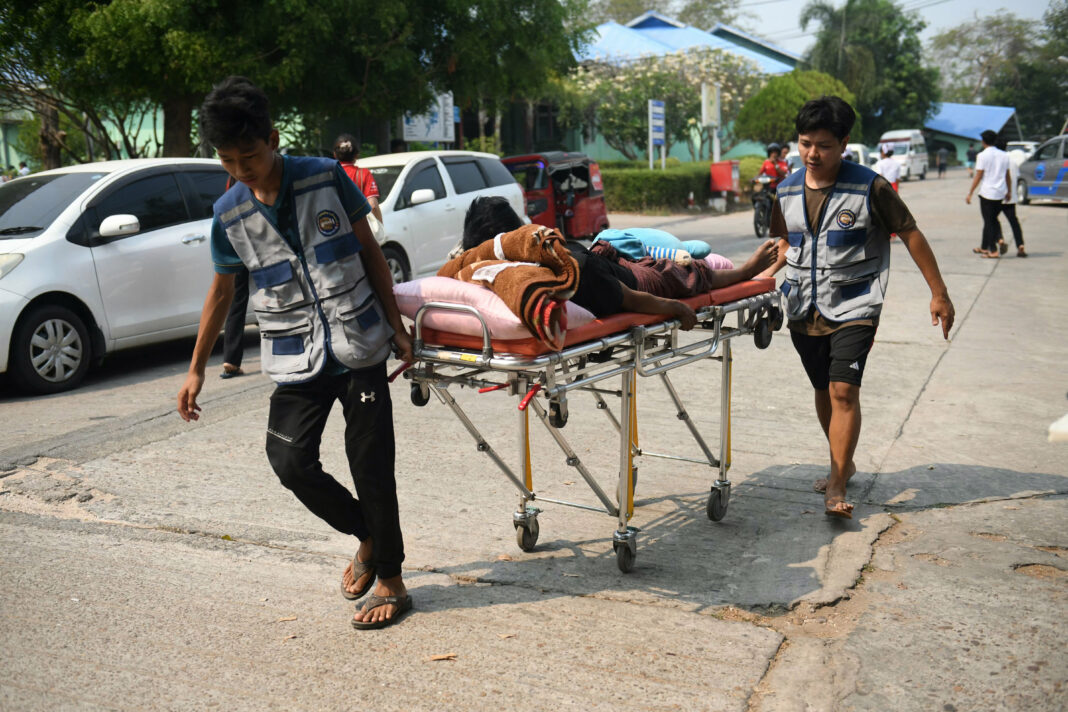LATEST UPDATE on 29 March at 12:48 PM
The deadly 7.7-magnitude earthquake that rocked central Myanmar on 28 March has claimed the lives of at least 1,002 people so far, with over 2,300 others reported injured and thousands missing.
As rescue efforts continue, officials fear the toll could rise significantly, with the United States Geological Survey estimating that the final death count could reach as high as 10,000.
Widespread Destruction and Chaos
The earthquake, which struck with its epicenter located northwest of Sagaing, hit the city of Mandalay particularly hard.
Nearly 700 of the confirmed dead are from Mandalay, Myanmar’s second-largest city. Other areas also saw dozens of losses, with 94 deaths reported in Naypyidaw, the capital, 30 in Kyauk Se, and 18 deaths in Sagaing.
The tremors caused extensive infrastructure damage, with roads buckling and buildings collapsing. Among the many damaged structures was the National Museum in Naypyidaw, where ceilings caved in, forcing staff to flee for safety.
The region’s overwhelmed hospitals are struggling to manage the influx of injured individuals.
Emergency Response and International Aid Appeal
In the aftermath of the earthquake, the ruling Myanmar military government has declared a state of emergency across six regions: Sagaing, Mandalay, Bago, Magway, Shan State, and the capital, Naypyidaw.
Junta chief Min Aung Hlaing visited hospitals in Naypyidaw to assess the situation firsthand and has made a rare appeal for international humanitarian assistance.
The earthquake has overwhelmed local medical facilities, with hospitals in Mandalay, Naypyidaw, and Sagaing inundated with injured individuals.
There is an immediate need for blood donations and medical supplies to address the crisis.
This disaster compounds the existing humanitarian challenges in Myanmar, a nation already grappling with civil conflicts, political instability and economic crisis.
The junta’s appeal for international aid highlights the severity of the situation and the necessity for a global response to support the affected communities.
Disaster Spreads Beyond Myanmar’s Borders
The earthquake’s tremors were felt far beyond Myanmar’s borders, with nearby countries like Thailand, Laos, and China also experiencing the effects.
In Thailand, the collapse of a 30-story building in Bangkok, under construction at the time of the quake, has claimed at least eight lives.
More than 100 workers remain trapped under the rubble, and efforts to locate them are ongoing.
The collapse of the building in Bangkok has sparked controversy, with many questioning the safety of the project.
The building was constructed by China Railway No. 10 Engineering Group, a state-owned Chinese company, in a joint venture with Italian-Thai Development PLC. Originally hailed as a showcase of Chinese engineering, the project was heavily promoted online.
However, shortly after the collapse, the project’s Chinese contractor, China Railway No. 10 Engineering Group, has removed all related press releases and construction images from their online platforms, fueling public scrutiny.
Over 2,000 reports of structural cracks in buildings across Bangkok were submitted by the public overnight, prompting the government to plan detailed inspections of 700 structures, according to the regional governor on 28 March.
The majority of the cracks were reported in the inner city, where high-rise buildings are most concentrated, while outlying districts experienced minimal damage. Bangkok Governor Chadchart Sittipunt confirmed that additional inspections would take place throughout the weekend.
In addition to the building collapse, the earthquake also triggered the suspension of metro and light rail services in Bangkok, further compounding the crisis in the Thai capital.
Myanmar’s Earthquake History
Myanmar, situated along the active Sagaing Fault, has long been vulnerable to seismic activity.
The country experienced six major quakes above 7.0 magnitude between 1930 and 1956. More recently, a 6.8-magnitude quake in 2016 killed three people and severely damaged Bagan’s ancient temples.
Experts have long warned that Myanmar’s rapid urbanization, coupled with weak building codes and poor infrastructure, has left its cities, especially Mandalay and Naypyidaw, highly susceptible to natural disasters.
What’s Next?
The death toll is expected to continue rising as more bodies are uncovered in the rubble, and rescue operations are ongoing.
With 77 aftershocks recorded by 6 AM today, residents are preparing for further tremors and potential damage.



